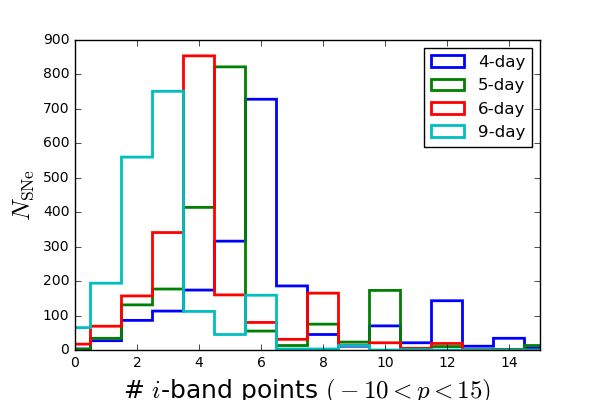| |
| META TOPICPARENT |
name="SNeIa" |
Simulation of SNe Observation for Survey Strategy Observations |
| | The SN Ia i-band requirements originate from: 1) lightcurves in at least three filters are necessary for SN Ia distances; 2) SN Ia physics science based on measuring the characteristics of the second peak (time and peak flux) visible at filters redder than the R-band; 3) Detection of the second peak is a unique feature of SNe Ia, and can be used to photometrically type the full sample after the survey complete, which is necessary for detailed and unbiased SN rates studies above the spectroscopic threshold of z=0.1.
SN Ia cosmology |
|
<
< | The primary goal of the ZTF SN Ia survey is to provide a low-z legacy sample for future cosmology analyses. To reach this goal, we require lightcurves of 2000 SNe Ia in at least three bands, as described in the white paper, where the lightcurve of each SN in the sample needs to be measured with a statistical precision that is at the level or better than the intrinsic uncertainty of SNe Ia. For ZTF the limitiation will be the effective cadence of the I-band survey. To estimate the properties of the I-band peak we need at least four data points within -10 < p < +15 days with respect to time of maximum, with at least one point before and one point after maximum. Based on simulation we conclude that this criteria will be reached for xx-XX, yy-YY, zz-ZZ of the discovered SN Ia sample at z<0.1 for a 4,5,6 and 9 day cadence respectively. The range corresponds to the expected uncertainty due to the weather conditions. The simulations have been carried out assuming weather conditions for 2013 and 2016. The full histogram is shown below. |
>
> | The primary goal of the ZTF SN Ia survey is to provide a low-z legacy sample for future cosmology analyses. To reach this goal, we require lightcurves of 2000 SNe Ia in at least three bands, as described in the white paper, where the lightcurve of each SN in the sample needs to be measured with a statistical precision that is at the level or better than the intrinsic uncertainty of SNe Ia. For ZTF the limitiation will be the effective cadence of the I-band survey. To estimate the properties of the I-band peak we need at least four data points within -10 < p < +15 days with respect to time of maximum, with at least one point before and one point after maximum. Based on simulation we conclude that this criteria will be reached for 77-88%, 62-82%, 42-70% or 13-18% of the discovered SN Ia sample at z<0.1 for a 4,5,6 and 9 day cadence respectively. The range corresponds to the expected uncertainty due to the weather conditions. The simulations have been carried out assuming weather conditions for 2013 and 2016. The full histogram is shown below. |
| |

SN Ia physics with the I-band |
|
<
< | The time and characteristic of the second peak is both correlated with the Ni mass of the SN Ia, and provides a promising path for improving standardization of SNe Ia for cosmology. In order to obtain an unbiased measurement of the second peak, it is not enough to sample only the peak itself but also to capture the minimum between the two peaks. In order to do this we require at least 6 datapoints between 10 < p < 50 which will be reached for xx-XX, yy-YY, zz-ZZ of the discovered SN Ia sample at z<0.1 for a 4,5,6 and 9 day cadence respectively. |
>
> | The time and characteristic of the second peak is both correlated with the Ni mass of the SN Ia, and provides a promising path for improving standardization of SNe Ia for cosmology. In order to obtain an unbiased measurement of the second peak, it is not enough to sample only the peak itself but also to capture the minimum between the two peaks. In order to do this we require at least 6 datapoints between 10 < p < 50 which will be reached for 68-82%, 44-66%, 26-48% or 11-15% of the discovered SN Ia sample at z<0.1 for a 4,5,6 and 9 day cadence respectively. |
| |
 |

